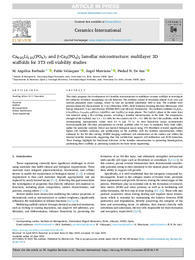Título :
Ca9.95Li1.05(PO4)7 and β-Ca3(PO4)2 lamellar microstructure: multilayer 3D
scaffolds for 3T3 cell viability studies |
Autor :
Barbudo, M. Angélica
Velásquez, Pablo
Murciano, Ángel
De Aza, Piedad N. |
Editor :
Elsevier |
Departamento:
Departamentos de la UMH::Ciencia de Materiales, Óptica y Tecnología Electrónica |
Fecha de publicación:
2025 |
URI :
https://hdl.handle.net/11000/36772 |
Resumen :
This study proposes the development of a lamellar microstructure in multilayer ceramic scaffolds to investigate
the influence of surface morphology on cell behavior. The scaffolds consist of tricalcium silicate (C3S) core and
calcium phosphate outer coatings, where Ca ions are partially substituted with Li ions. The scaffolds were
physicochemically characterized by X-ray diffraction (XRD), Field Emission Scanning Electron Microscopy with
Energy Dispersive X-ray spectroscopy (FESEM/EDX) and Mercury Porosimetry. The scaffolds exhibited Ca2P2O7,
β-Ca3(PO4)2, Ca9.95Li1.05(PO4)7, CaLi(PO4) and Li3(PO4) as main phases. The Ca2P2O7 phase in the outer layer
was removed using a 30-s etching process, revealing a lamellar microstructure in the bulk. The compressive
strength of the scaffolds was 1.2 ± 0.1 MPa for the control and 0.9 ± 0.1 MPa for the C30s scaffolds, while the
corresponding microporosity values were 61 % and 72 %. In vitro bioactivity assays demonstrated
hydroxyapatite-like (HA-like) precipitation on etched scaffolds after 14 days in simulated body fluid (SBF),
unlike the untreated controls. Direct and indirect biological assays using 3T3 fibroblasts revealed significantly
higher cell viability, adhesion, and proliferation on the scaffolds with the lamellar microstructure, futher
enhanced by the HA-like coating. FESEM imaging confirmed cell colonization on the surface and within the
internal lamellar framework, suggesting that this architecture supports cell infiltration and ECM formation.
These findings highlight the functional relevance of the lamellar microstructure in promoting biointegration,
positioning these scaffolds as promising candidates for bone tissue engineering.
|
Palabras clave/Materias:
Scaffold
Biocompatibility
Surface modification
Tissue engineering |
Área de conocimiento :
CDU: Ciencias aplicadas: Ingeniería. Tecnología |
Tipo de documento :
info:eu-repo/semantics/article |
Derechos de acceso:
info:eu-repo/semantics/openAccess
Attribution-NonCommercial-NoDerivatives 4.0 Internacional |
DOI :
https://doi.org/10.1016/j.ceramint.2025.06.145 |
Publicado en:
Ceramics International (2025) |
Aparece en las colecciones:
Artículos - Ciencia de los materiales, óptica y tecnología electrónica
|
 La licencia se describe como: Atribución-NonComercial-NoDerivada 4.0 Internacional.
La licencia se describe como: Atribución-NonComercial-NoDerivada 4.0 Internacional.
.png)
